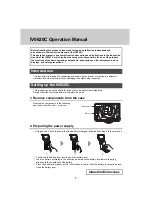
XT2640 Operating Manual
13 July 2016
Page 65 of 187
12.10.2.3
RUNNING
A
SCOPE
CAPTURE
The oscilloscope may be run in either SINGLE or CONT modes similarly to a normal oscilloscope.
Pressing the CONT button starts continuous oscilloscope captures.
While capturing in CONT mode the button is colored green and is labelled RUNNING. Shortly after triggering and capturing
all signals, the scope will wait for another trigger event. While capturing in CONT mode you may press the CONT button to
stop capturing signals, or may press the button to its right to make a SINGLE mode capture instead.
Pressing the SINGLE button starts a single oscilloscope capture.
While capturing in SINGLE mode the button is colored green. After triggering and capturing all signals, the scope will stop.
While capturing in SINGLE mode you may press the SINGLE button to abort the capture, or may press the CONT button to
initiate CONT mode instead.
While capturing, the SINGLE button is labelled with the status of the scope signal capture‐
PRETRIG. Indicates that the scope is collecting sufficient signal to accommodate the configured trigger position.
WAITING. Indicates that the scope is waiting for a trigger event.
TRIG’D. Indicates that the scope is collecting the signals after a trigger event has been detected but there is not enough
signal captured to fill the screen yet.
Recommendations:
The BANDWIDTH setting for the VPA also bandwidth limits all signals for the scope. This can limit your ability to use the
HF trigger type if set for a fast timebase. If you intend to use the HF trigger type to detect very fast glitches on a much
lower frequency signal then it is recommended to configure the VPA measurements for an BANDWIDTH setting of
UNFILTERED. If using the INRUSH capture mode then the BANDWIDTH is ignored during the scope capture. The actual ‐
3dB bandwidth of the captured signals is displayed below the chart.
If the intention is to trigger on an inrush event, then the use of the ABS(DC) trigger type is recommended, using the current
signal as the trigger source and setting the trigger level to a suitable current level which you expect the inrush current to
exceed. Typically SINGLE captures are used for inrush capture.
If the intention is to trigger on a mains supply surge then the ABS(DC) trigger type is recommended, using the voltage
signal as the trigger source and setting the trigger level to a suitable voltage level just above the peak level of the highest
expected normal mains voltage. Typically CONT mode is used for mains supply surge capture as this enables the XT2640 to
detect another surge without user intervention.
If the intention is to trigger on mains supply ‘glitches’ then the HF trigger type is recommended, using the voltage signal as
the trigger source and setting the trigger level to a voltage level just high enough to not trigger on whatever glitches are
normally present. Typically CONT mode is used for mains supply glitch capture as this enables the XT2640 to detect
another glitch without user intervention.
For capturing repetitive signals then the use of the DC(rising) or DC(falling) trigger types is recommended, however you
should also consider using CYCLE VIEW as this provides better trace resolution in time and requires no configuration.
Just as for all digital sampling oscilloscopes, setting the timebase to a very long value and attempting to capture a higher
frequency signal will cause aliasing in the captured data making the captured signal look like it has a much lower frequency
than it actually has. The XT2640 has an internal scope capture depth of 32768 samples. You should always set an
appropriate timebase considering the frequency of the signal expected.
Note:
Since the scope view capture is intended for the capture of non‐repetitive signals it gains no advantage from the advanced
sampling system in the XT2640 and scope view data has the time resolution of individual samples of the signals. For W
channel types this is just over 1µs, otherwise it is just over 4µs.
12.10.2.4
VIEWING
A
SCOPE
CAPTURE
The last taken scope capture is shown with the traces selected and configured as described above. To the left of the chart is a listing
of the configured traces. Below the chart is a textual description of the trigger configuration.
Note:
If no signals have been captured then NO DATA CAPTURED is displayed on the chart and the chart is blank.
















































